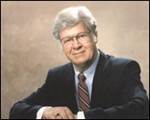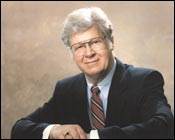John Morena: A Patented Success
A pioneer of innovative moldmaking methods, this advocate of moldmaking education has shared the wealth through his books and patents.
| John Morena has spent nearly half a century in the plastics, composites and materials engineering fields-taking on key roles in education, technology development and marketing in the moldmaking industry. He also is the author of two editions of the book Advanced Composite Mold Making and the holder of a number of patents-quite a testament to his knowledge and expertise in the field!
A wearer of many hats, Morena currently is the founder of American Composite Education, Inc. (ACE Inc.)-a composites, materials and processes training organization and consulting firm specializing in the design, manufacture of master models, molds and tools, and composite manufacturing processes-which he started back in 1980. He also serves as a principal, executive director and program developer of MAGLEV 2000 of Florida Corporation (Titusville, FL) and DP Maglev Technology, Inc. (CA- and NY-based)-a developer and implementer of the newly created magnetic levitation transportation system. According to Morena, Maglev vehicles travel at speeds of 350 mph and greater-riding on and over a monorail with no wheels. Levitation and propulsion are provided by the magnetic fields supplied by superconducting magnets. The MAGLEV 2000 vehicle(s) is fabricated from reinforced polymer laminated structures.
Starting OutMorena's path toward moldmaking began in New York, where he attended New York University (Farmingdale, NY)-participating in a work/study program. He also was an instructor in the Plastics Technology short course program. His first job was at American Bosch Arma Corporation, (Garden City, NY)-a manufacturer of propulsion and aerodynamic components, where he worked in the materials engineering lab developing materials and processes for molds for the Atlas missile program. He also developed molding methods for air passage surfaces and other components of the B-2 Bomber. "I got into making the tools to mold radar absorbent and radar reflective materials," Morena explains. "Every aspect of what I tried to do back then-which applies to this day-is to take my moldmaking, materials and processes experience and apply it to developing unique applications and technologies in various industries." In 1962, he was hired as a senior materials engineer/certified manufacturing engineer at Airborne Instrument Lab (Deer Park and Melville, NY)-where he was responsible for the design and fabrication of molds and tools in the biomedical, commercial and military industries. After that, he held similar responsibilities at Morristown, NJ-based Airtron-designing molds for microwave components. "I designed the moldmaking methods to mold plastic components," he states. "Microwave components can't be made out of plastic because they need to reflect microwaves. I created and developed the electroless plating methods so moldmakers could plate on the plastic after the components were molded in the molds and turn them into microwave components because they had metal surfaces."In 1972, Morena made a foray into the music industry as a result of his passion for playing drums in a jazz group. As vice president of Fibes Drums (Farmingdale, NY), he designed and built molds and tools needed to mold fiberglass and acrylic musical drums, which were patented. It would be the first of several patents for Morena. "The molds that were designed were very unique," he recalls. "We centrifugally cast the component drum shells in a way that had never been done before." (See Spin Control Sidebar) Book SmartIn the mid-eighties, the field of education was the next to benefit from Morena's experience. He taught short courses on moldmaking and associated composite manufacturing processes at the Manufacturing Learning Center at Florida Atlantic University (Boca Raton). During this time, he also decided to share his abundant knowledge by publishing a moldmaking book. "If the moldmaker doesn't know all of the methods of the part making process, how can they know which moldmaking process works best for each customer?" Morena questions. "This is why I spent five-and-a half years of my life writing my book." He adds that today the book is considered a "bible" for the moldmaking industry. Four years later, a second edition was published. Morena also wrote the Advanced Composite World Reference Dictionary for Krieger Publishing, (Malabar, FL) and the Mold Making Chapter of Composite Mold Making for the International Encyclopedia of Composites published by German-based VCH Publishing. After he published his first book in 1988, Morena started working for the U.S. Department of Energy (DOE)-specifically as the primary technical advanced manufacturing and materials advisor at The Superconducting Super Collider Laboratory (Dallas, TX) and the Relativistic Heavy Ion Collider, Brookhaven National Laboratory (Upton, NY), where he was responsible for the tooling and molding of components for superconducting magnets that operated at cryogenic temperatures. "At that time, this was to be the world's largest accelerator-fifty-four miles in circumference," Morena recalls. "I was one of the only materials scientists back then who was able to formulate and select materials that could be used in high radiation environments and at very low temperatures like -454xF, which is almost absolute zero." His experience at the DOE prepared him for his current responsibilities at MAGLEV 2000, where he is involved in designing composite tooling and vehicle components-including a sixty-foot long fuselage as well as some of the components that go into the cryogenic system. "At MAGLEV 2000, I have the ability to take state-of-the-art moldmaking technologies and apply them to this advanced transportation technology," he notes. "It is truly exciting." Over the past forty-six years, there is no doubt that Morena has learned-and shared-vast numbers of technologies in a wide variety of industries (see Jack-of-All-Trades Sidebar). He offers the following advice to his peers, "Try to apply your knowledge in broad industrial areas and select industrial application areas where your experience can help you become a leader in that area. Never stop learning through applications and hands-on involvement. Then-when you are ready-take all of your experience and document it in a published book or two so your credibility is established internationally."There is no doubt that Morena plans to keep practicing what he preaches. "I will continue to advise and consult in both state-of-the-art and advanced materials and processes, in multi-industry applications and in helping companies and individuals create new composite materials, processes, molds, tools and products. Then, I'll continue to support them with the marketing and sales of those created by using innovative approaches." |
Related Content
Tackling a Mold Designer Shortage
Survey findings reveal a shortage of skilled mold designers and engineers in the moldmaking community, calling for intervention through educational programs and exploration of training alternatives while seeking input from those who have addressed the issue successfully.
Read MoreMMT Chats: Solving Schedule and Capacity Challenges With ERP
For this MMT Chat, my guests hail from Omega Tool of Menomonee Falls, Wisconsin, who share their journey with using enterprise resource planning (ERP)—and their people—to solve their schedule and capacity load monitoring challenges.
Read MoreThe Role of Social Media in Manufacturing
Charles Daniels CFO of Wepco Plastics shares insights on the role of social media in manufacturing, how to improve the “business” side of a small mold shop and continually developing culture.
Read MoreEditorial Guidelines: Editorial Advisory Board
The Editorial Advisory Board of MoldMaking Technology is made up of authorities with expertise within their respective business, industry, technology and profession. Their role is to advise on timely issues, trends, advances in the field, offer editorial thought and direction, review and comment on specific articles and generally act as a sounding board and a conscience for the publication.
Read MoreRead Next
Jim Meinert: An International Success
The world is his marketplace as this industry veteran goes from running an American mold shop to consulting clients in sales and marketing—here and abroad.
Read MoreAre You a Moldmaker Considering 3D Printing? Consider the 3D Printing Workshop at NPE2024
Presentations will cover 3D printing for mold tooling, material innovation, product development, bridge production and full-scale, high-volume additive manufacturing.
Read MoreHow to Use Strategic Planning Tools, Data to Manage the Human Side of Business
Q&A with Marion Wells, MMT EAB member and founder of Human Asset Management.
Read More


















